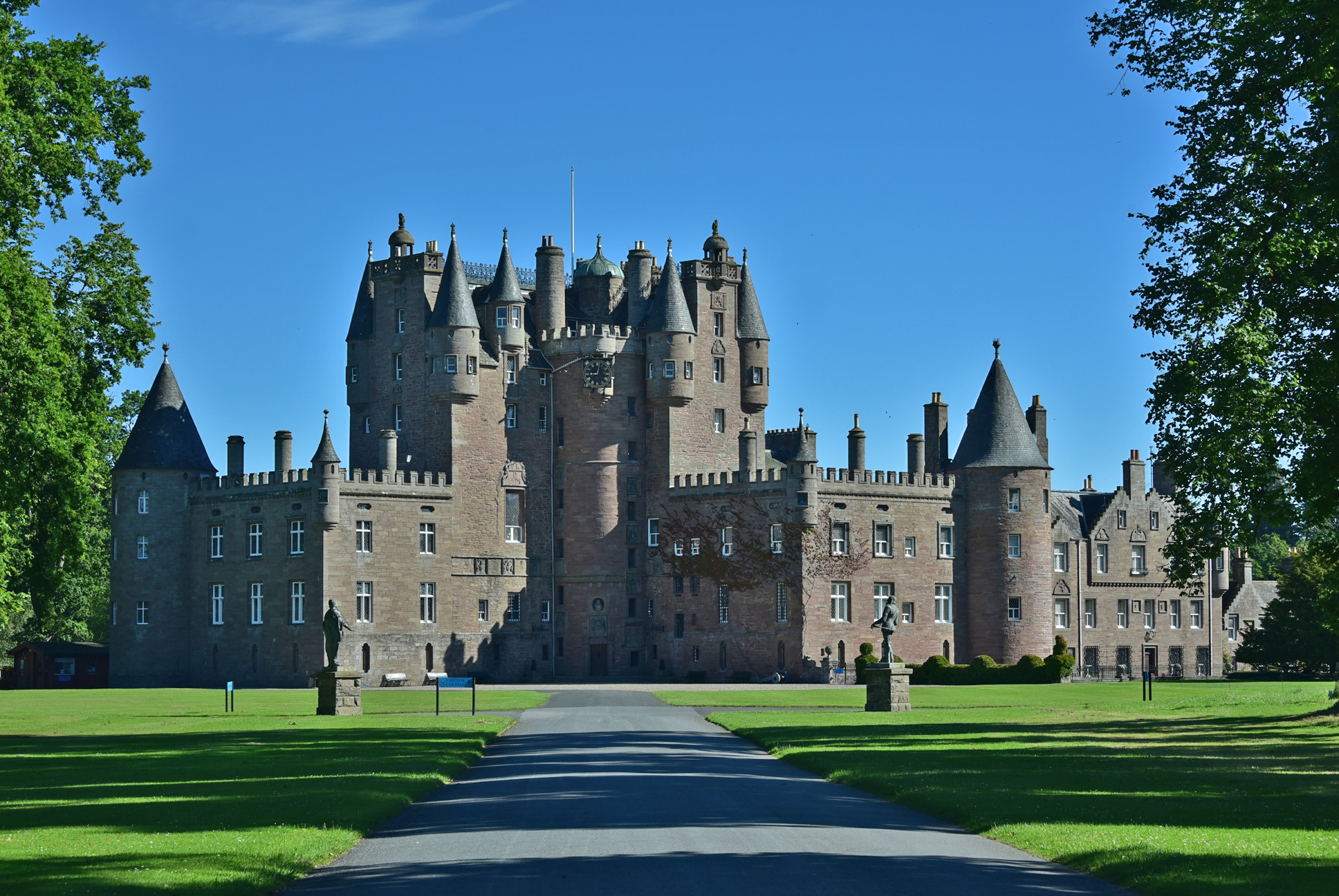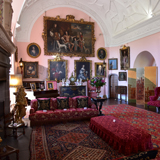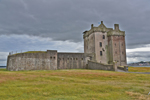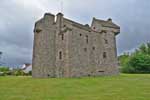History
Glamis Castle is located in the fertile valley of Strathmore in Angus, Scotland, on lands steeped in history that predate the castle. The Earls of Strathmore and Kinghorne have lived at Glamis Castle since 1372.

King Malcolm II died at Glamis on November 25th, 1034, at the age of at least 80, when there was a Royal Hunting Lodge where the castle now stands. It is hard to know when the castle was built as its early history is clouded. Still, some documented history does show that the land was in the possession of the Baliol family for some time until 1329, when Robert the Bruce took back Glamis into the protection of the Crown.
By 1372, a castle must have existed at Glamis as King Robert II granted the Thanage of Glamis to Sir John Lyon for services to the Crown on March 18th, 1372, which gave him "the free barony of Glamuyss in the sheriffdom of Forfar." Sir John married Princess Johanna Stewart, the daughter of Robert II, in 1376.
In 1400, the Glamis Castle we see today gets underway, built as an L-Plan Tower house. Construction of the Great Tower began in 1435 and took about 50 years to complete. John's grandson, Sir Patrick Lyon, would gain the title of 1st Lord Glamis on June 28th, 1445. Besides Glamis Castle, he was the Keeper of the Scottish castles of Kildrummy, Kindrocht, and Balveny from 1456-1459.
The 6th Lord Glamis, Sir John Lyon, married Janet Douglas, daughter of George Douglas, Master of Angus, at a time when King James V was feuding with the Douglases. Soon after Sir John died, King James falsely accused Lady Glamis, Janet, of witchcraft, and she was burned at the stake on Castle Hill in Edinburgh on July 17th, 1537. James would then seize Glamis Castle and live there for four years; his coat of arms can still be seen above the main door of the castle.
After King James' death, steps were taken to fix the injustices done during his reign. Lady Glamis was posthumously proved innocent of witchcraft, and in 1543, Glamis Castle was returned to Sir John Lyon, 7th Lord Glamis. In a final act of reconciliation, James' teenage daughter, Mary Queen of Scots, visited Glamis Castle on August 22nd, 1562. Mary stayed at the castle for two nights, dining in the Great Hall. Her visit restored the bond between the Lyon family and the Scottish Monarchy.
In 1606, Patrick Lyon, 9th Lord Glamis, was created the 1st Earl of Kinghorne by King James VI of Scotland (King James I of England). Patrick began redesigning the castle with the help of the King's Master Mason, William Schaw. Soldiers were garrisoned at Glamis Castle during the Commonwealth of England, Scotland, and Ireland when Cromwell's troops occupied the castle in 1650. When Patrick, the 3rd Earl of Kinghorne, returned to the castle in 1670, he found it uninhabitable.
Patrick began restoration work of the castle from 1670 to 1689, which included raising the Great Tower to new heights and creating a Baroque-style garden, among numerous other changes that gave the castle a unique blend of Scottish and French architecture with Norman-inspired turrets surrounding a Scottish-style tower house. The Great Hall, now the Drawing Room, was also refurbished. Patrick was created Earl of Strathmore and Kinghorne by King Charles II in 1677. In 1688, the Chapel was completed and dedicated.
In 1715, John, 5th Earl, was killed while fighting with the Jacobites at the Battle of Sheriffmuir. His younger brother Charles, 6th Earl, would host James Stuart, "The Old Pretender," at Glamis Castle in 1716. By 1746, The Duke of Cumberland's troops would occupy the castle. In 1767, the 9th Earl, John Lyon, married the wealthy English heiress Mary Eleanor Bowes, and the family changed their name to Bowes-Lyon. John made more changes to the castle in the 1770s, pulling down the west wing and adding a new kitchen and the Billiards Room. By 1801, the rebuilding of the west wing was completed.
Several rooms date from the 18th and 19th centuries, including the Dining Room. The southwest wing of the castle was also rebuilt after a fire in the early 19th century. In 1891, the 13th Earl completed the building of the east wing.
In 1900, The 14th Earl, Claude Bowes-Lyon, and his wife Cecilia would have a daughter, Lady Elizabeth Bowes-Lyon, who spent much of her childhood at Glamis Castle. The castle would be used as a military hospital during World War I. Elizabeth organized the rescue of the castle's contents during a severe fire on September 16th, 1916. On April 26th, 1923, Elizabeth married Prince Albert, Duke of York, at Westminster Abbey and became Her Royal Highness the Duchess of York. In 1930, Princess Margaret was born at Glamis Castle.
Prince Albert would become King George VI in 1936 after his brother, King Edward VIII, abdicated the Crown, making Elizabeth Queen Consort. Their daughter would become Queen Elizabeth II.
In 1950, Glamis Castle opened its doors to the public and is still home to the Earls of Strathmore and Kinghorne for over 650 years.
Castle Highlights
Glamis Castle is breathtaking as you approach from the tree-lined avenue leading to the castle. Its red sandstone walls and tall turreted towers are both romantic and foreboding simultaneously. The castle has some parkland and formal gardens to explore. It was initially a tower house-style castle, but with additions through the centuries, it has expanded into a "W" plan castle with wings on both sides of the central Great Tower.
The castle can be explored via a guided tour, and you are free to roam around on your own. This castle is still home to the Earls of Strathmore and Kinghorne and their family, and the rooms are packed with furniture and give a great representation of what castles were like in their heyday.
The Drawing Room today used to be the Great Hall where guests would be entertained. It is still the heart of the castle. A large painting of Patrick, 3rd Earl of Strathmore and Kinghorne, and his family can be seen high on one wall of the room, as well as other family pictures displayed throughout the room.
The Crypt has an entirely different feel, more medieval, with cold stone walls adorned with Victorian hunting trophies. There are also a few suits of armor and breastplates scattered about the room. The castle's Chapel can seat 46 people and still hosts family functions. But one seat is always reserved for the "White Lady," one of the ghosts that live in the castle.
Other rooms are also worth exploring, such as the Billiards Room, Dining Room, The King's Room, a few formal bedrooms, and a display of royal robes worn to the 1937 coronation of King George VI and Queen Elizabeth, the Queen Mother.
Glamis Castle can be explored in 3 to 4 hours. If you would like to make a full day of taking in Scottish History, Scone Palace is close to Glamis.
Glamis Castle is also haunted.




